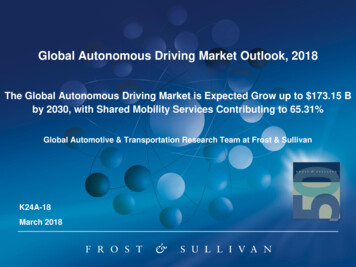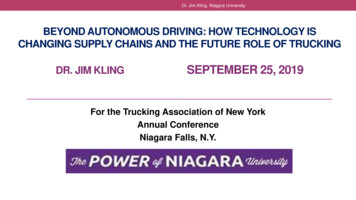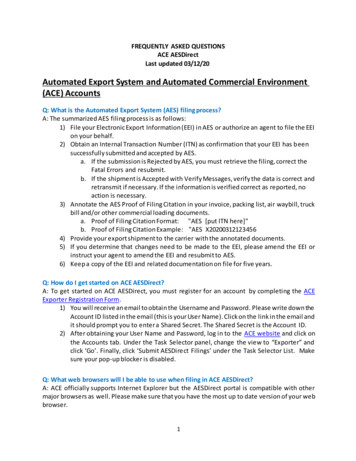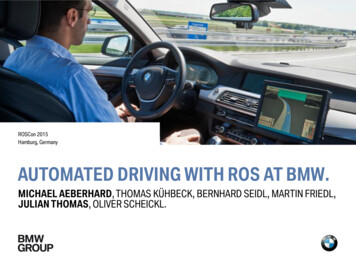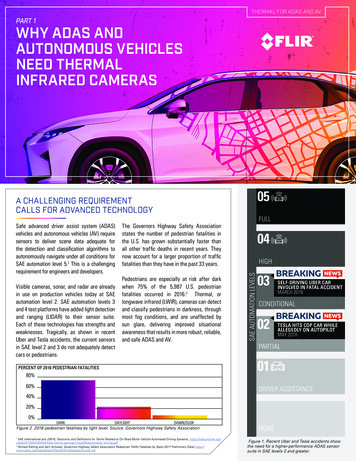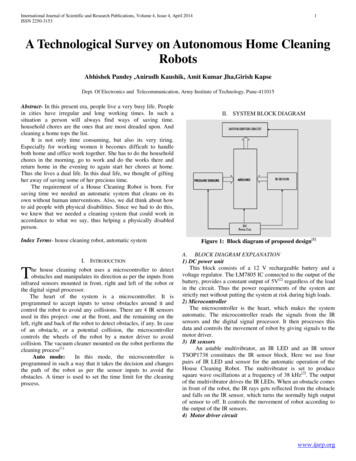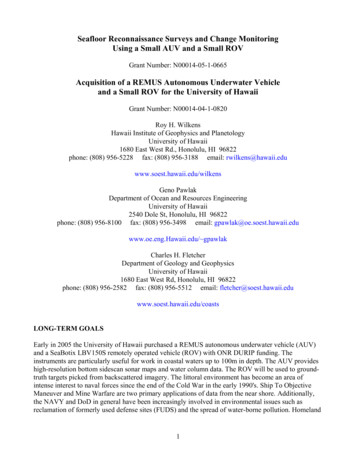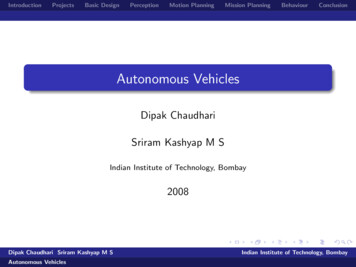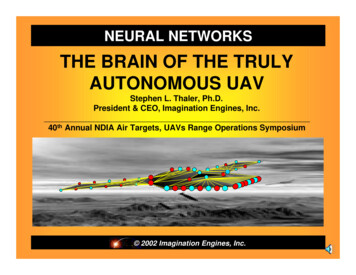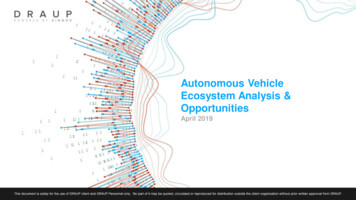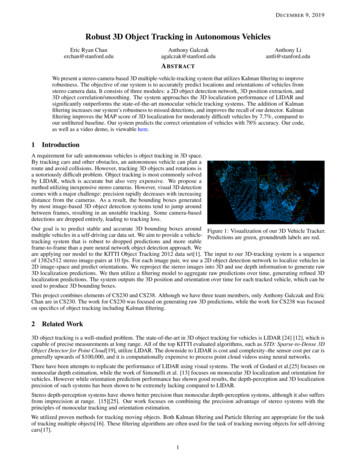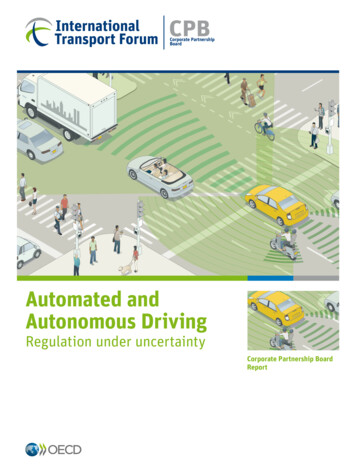
Transcription
CPBCorporate PartnershipBoardAutomated andAutonomous DrivingRegulation under uncertaintyCorporate Partnership BoardReport
Automated andAutonomous DrivingRegulation under uncertaintyCorporate Partnership BoardReport
About the International Transport ForumThe International Transport Forum at the OECD is an intergovernmental organisation with 54 membercountries. It acts as a think tank for transport policy and organises the Annual Summit of transportministers. ITF is the only global body that covers all transport modes.ITF works for transport policies that improve peoples’ lives. Our mission is to foster a deeper understandingof the role of transport in economic growth, environmental sustainability and social inclusion and to raisethe public profile of transport policy.ITF organises global dialogue for better transport. We act as a platform for discussion and pre-negotiationof policy issues across all transport modes. We analyse trends, share knowledge and promote exchangeamong transport decision makers and civil society.Our member countries are: Albania, Armenia, Australia, Austria, Azerbaijan, Belarus, Belgium, Bosnia andHerzegovina, Bulgaria, Canada, Chile, China (People’s Republic of), Croatia, Czech Republic, Denmark,Estonia, Finland, France, Former Yugoslav Republic of Macedonia, Georgia, Germany, Greece, Hungary,Iceland, India, Ireland, Italy, Japan, Korea, Latvia, Liechtenstein, Lithuania, Luxembourg, Malta, Mexico,Republic of Moldova, Montenegro, Netherlands, New Zealand, Norway, Poland, Portugal, Romania, RussianFederation, Serbia, Slovak Republic, Slovenia, Spain, Sweden, Switzerland, Turkey, Ukraine, UnitedKingdom and United States.DisclaimerThis report is published under the responsibility of the Secretary-General of the International Transport Forum. Funding for thiswork has been provided by the ITF Corporate Partnership Board. This report has not been subject to the scrutiny of InternationalTransport Forum member countries. The opinions expressed and arguments employed herein do not necessarily reflect the officialviews of member countries. This document and any map included herein are without prejudice to the status of or sovereignty overany territory, to the delimitation of international frontiers and boundaries and to the name of any territory, city or area.www.internationaltransportforum.org
TABLE OF CONTENTS–3Table of contentsExecutive summary .5Introduction .91.Automated and autonomous driving: Technologies,contexts and capabilities. 11Technologies and infrastructures . 11Capabilities and contexts . 132.Use cases, business cases and potential deployment pathways . 17Products and services . 18Deployment paths and technologies . 183.Regulatory environment . 25Types of regulation . 25Regulatory approaches . 25Regulatory considerations and policy choices . 26Key challenges . 28Proposals for different automation strategies . 29Annex: Current regulatory frameworks for the testing of autonomous vehicles . 30Bibliography . 33Figures1.Technologies that allow vehicles to sense, plan and act in response to the dynamic driving environment . 112.Levels of driving automation according to the Society of Automotive Engineers . 143.Transition from high to full driving automation across different contexts . 164.Urban mobility pathway from human to fully automated driving . 215.Automated private vehicle pathway from human to fully automated driving . 226.Heavy-duty truck automation pathway from human to fully automated driving . 237.Types of regulation for automated driving . 25AUTOMATED AND AUTONOMOUS DRIVING: REGULATION UNDER UNCERTAINTY - OECD/ITF 2015
EXECUTIVE SUMMARY–5Executive summaryMany cars sold today are already capable of some level of automated operation, and prototype cars capableof driving autonomously have been - and continue to be - tested on public roads in Europe, Japan and theUnited States. These technologies have arrived rapidly on the market and their future deployment isexpected to accelerate. Autonomous driving promises many benefits: improved safety, reduced congestionand lower stress for car occupants, among others. Authorities will have to adapt existing rules and createnew ones in order to ensure the full compatibility of these vehicles with the public’s expectations regardingsafety, legal responsibility and privacy. This report explores the strategic issues that will have to beconsidered by authorities as more fully automated and ultimately autonomous vehicles arrive on our streetsand roads. It was drafted on the basis of expert input and discussions amongst project partners in additionto a review of relevant published research and position papers.What we foundAutomated driving technologies are mostly mature and some autonomous driving is here alreadyMost of the core technologies required for fully autonomous driving are available today, many are matureand some are already being deployed in commercially available vehicles.Self-driving cars seem a near-term possibility but their range of capabilities is unclearMany major car manufacturers and several technology firms have announced the commercial production ofhighly automated vehicles starting in 2017. Many observers expect there to be a wide range of such modelson the market by 2030, and some of these may be self-driving. It is not clear at present, however, to whatextent these vehicles will be capable of self-driving in all circumstances.Road safety is expected to improve with vehicle automation. But this effect remains untested at a largescale and may not be immediate or linearMost crashes involve human error. If greater autonomous operation reduces or eliminates these errors,then benefits for road safety may be substantial. However, most driving involves no crashes. The realsafety test for autonomous cars will be how well they can replicate the crash-free performance of humandrivers. While results from early prototypes are promising, new types of crashes may emerge asautonomous technologies become more common – for instance crashes resulting from the car handingcontrol back to the driver or from mixing autonomous and conventional vehicles.There are many possible technological configurations for autonomous drivingThe move towards autonomous driving may involve different technological configurations. Some rely ongreater connectivity between cars and between cars and infrastructure. These entail the development ofcommon communication protocols, encrypted security standards and investment in new types ofinfrastructure or upgrading those which currently exist. Others rely more on vehicle-embarked sensorplatforms and require little infrastructure investment. Both models require precise digital representations oftheir environment, including high definition maps.There are two incremental paths towards full automationThe first path involves gradually improving the automation in conventional vehicles so that human driverscan shift more of the dynamic driving task to these systems. The second path involves deploying vehicleswithout a human driver in limited contexts and then gradually expanding the range and conditions of theiruse. The first path is generally embraced by traditional car manufacturers and the second by new entrants.AUTOMATED AND AUTONOMOUS DRIVING: REGULATION UNDER UNCERTAINTY - OECD/ITF 2015
6 – EXECUTIVE SUMMARYUse and business cases are closely linked to automation pathwaysIncremental advances in automation in conventional vehicles are unlikely to fundamentally change vehiclemarket dynamics. It seems likely that individuals will buy and own such upgraded cars much as they dotoday. Automated driving will be available for certain situations – for instance when driving on motorways,parking a car, or handling stop-and-go traffic in case of congestion). Because the human driver mustresume active control when prompted to do so, such conditional automation raises particularly difficultissues of human-machine interaction that have not been satisfactorily solved. Fully self-driving cars on theother hand, will not face the same issue of human-machine coordination, although their use will likely beconfined to contexts where the vehicle can confidently handle the full range of driving complexity. Suchhighly specific contexts include particular routes and low-speed operations. Self-driving cars have a muchhigher potential for disruption. They may be deployed in fleet-wide systems that would fundamentallyreshape individual travel and have an impact on industries such as public transport and taxis.Some regulatory frameworks are being developed for prototype testing, but not for future use casesSeveral jurisdictions have passed or are considering rules that enable the testing, licensing and operation ofautonomous technologies and vehicles. Most address the safe operation of these vehicles on public roads,although with little coordination amongst jurisdictions. We could not find evidence of anticipatory regulatoryaction addressing the potential use cases that could result from large-scale deployment of highlyautonomous vehicles, such as the provision of quasi-public transport or taxi-like operations.Policy insightsAutomated driving comprises a diverse set of emerging concepts that must be understood individually andas part of broader trends toward automation and connectivityVehicle automation is part of a much larger revolution in automation and connectivity. The recent hallmarksof these revolutions – personal computers, mobile telephones, and the Internet – have converged and arenow blending with machines that sense and manipulate the physical environment. These machines includenot just automated motor vehicles but also drones, personal care robots, 3D printers, surveillance devices,and many others. Vehicles will change with growing automation but so too will their role in society, and inways that are hard to foresee. Policies should account for this uncertainty and ensure sufficient resilience toadapt to these changes or, at a minimum, not block changes that are desirable.Uncertainty on market deployment strategies and pathways to automation complicates the regulatory taskAutonomous vehicle regulation should ensure safety and prevent, or at least mitigate, market failures. Thistask is complicated by uncertainty on what it is that should be regulated and the risk that regulation may infact lock in one pathway to automation over a potentially better one. Though regulators may targetautonomous vehicles as a special case out of convenience, it may be preferable to adapt existing rules asmuch as possible. While desirable, early regulatory action carries risks as well. Prematurely codifyingrequirements can freeze unrealistic expectations – high or low – into the law in a way that causes the legalframework to lag rather than to lead. Some regulatory flexibility seems desirable, for instance allowingcircumscribed uses such as low speed urban operation or motorway platooning before implementing ablanket set of rules.Incrementally shifting the driving task from humans to machines will require changes in insuranceLiability remains an important barrier for the manufacturers and designers of autonomous vehicles.Expanding public insurance and facilitating greater private insurance could provide sufficient compensationto those injured by an automated vehicle while relieving some of the pressure on the tort system to providesuch a remedy. Enhanced vehicle insurance requirements by manufacturers, especially if combined withgreater flexibility in the administration of this insurance, could also provide a third-party check on theAUTOMATED AND AUTONOMOUS DRIVING: REGULATION UNDER UNCERTAINTY - OECD/ITF 2015
EXECUTIVE SUMMARY–7safety of automated systems. As automation increases, liability could gradually shift from drivers tomanufacturers and Original Equipment Manufacturers (OEMs). However, the allocation of liability amongthese parties remains challenging and adjudication methods have yet to be developed.The shift from human to machine may have an impact on what product information developers andmanufacturers of autonomous vehicles share, and with whomEducation of public actors, and of the public at large, is essential for developing effective regulations andsetting realistic expectations. Governments can facilitate public education by encouraging developers toshare specific data about their products and processes in order to benefit from more f
Many major car manufacturers and several technology firms have announced the commercial production of highly automated vehicles starting in 2017. Many observers expect there to be a wide range of such models on the market by 2030, and some of these may be self-driving. It is not clear at present, however, to what extent these vehicles will be capable of self-driving in all circumstances. Road .File Size: 1MBPage Count: 32
